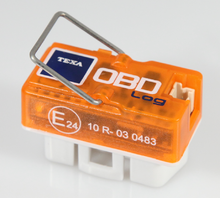Data Loggers
Data loggers are designed to capture vehicle data while the vehicle is in normal operation, for later analysis.
Data logging uses include:
- Engine and vehicle monitoring under normal operation, for the purpose of diagnosis or tuning.
- Some US auto insurance companies offer reduced premiums if OBD-II vehicle data loggers[18][19] or cameras[20] are installed – and if the driver’s behaviour meets requirements. This is a form of auto insurance risk selection
- Monitoring of driver behaviour by fleet vehicle operators.
Analysis of vehicle black box data may be performed on a periodic basis, automatically transmitted wirelessly to a third party or retrieved for forensic analysis after an event such as an accident, traffic infringement or mechanical fault.
Emission Testing
In the United States, many states now use OBD-II testing instead of tailpipe testing in OBD-II compliant vehicles (1996 and newer). Since OBD-II stores trouble codes for emissions equipment, the testing computer can query the vehicle’s onboard computer and verify there are no emission related trouble codes and that the vehicle is in compliance with emission standards for the model year it was manufactured.
In the Netherlands, 2006 and later vehicles get a yearly EOBD emission check.[21]
Driver’s Supplementary Vehicle Instrumentation
Driver’s supplementary vehicle instrumentation is instrumentation installed in a vehicle in addition to that provided by the vehicle manufacturer and intended for display to the driver during normal operation. This is opposed to scanners used primarily for active fault diagnosis, tuning, or hidden data logging.
Auto enthusiasts have traditionally installed additional gauges such as manifold vacuum, battery current etc. The OBD standard interface has enabled a new generation of enthusiast instrumentation accessing the full range of vehicle data used for diagnostics, and derived data such as instantaneous fuel economy.
Instrumentation may take the form of dedicated trip computers,[22] carputer or interfaces to PDAs,[23] smartphones, or a Garmin navigation unit.
As a carputer is essentially a PC, the same software could be loaded as for PC-based scan tools and vice-versa, so the distinction is only in the reason for use of the software.
These enthusiast systems may also include some functionality similar to the other scan tools.
Vehicle Telematics
OBD II is no longer only used by professionals and hobbyists to repair vehicles. OBD II information is commonly used by vehicle telematics devices that perform fleet tracking, monitor fuel efficiency, prevent unsafe driving, as well as for remote diagnostics and by Pay-As-You-Drive insurance. Although originally not intended for the above purposes, commonly supported OBD II data such as Vehicle Speed, RPM, and Fuel Level allow GPS based fleet tracking devices to monitor vehicle idling times, speeding, and over-revving. By monitoring OBD II DTCs a company can know immediately if one of its vehicles has an engine problem and by interpreting the code the nature of the problem. OBD II is also monitored to block mobile phones when driving and to record trip data for insurance purposes

